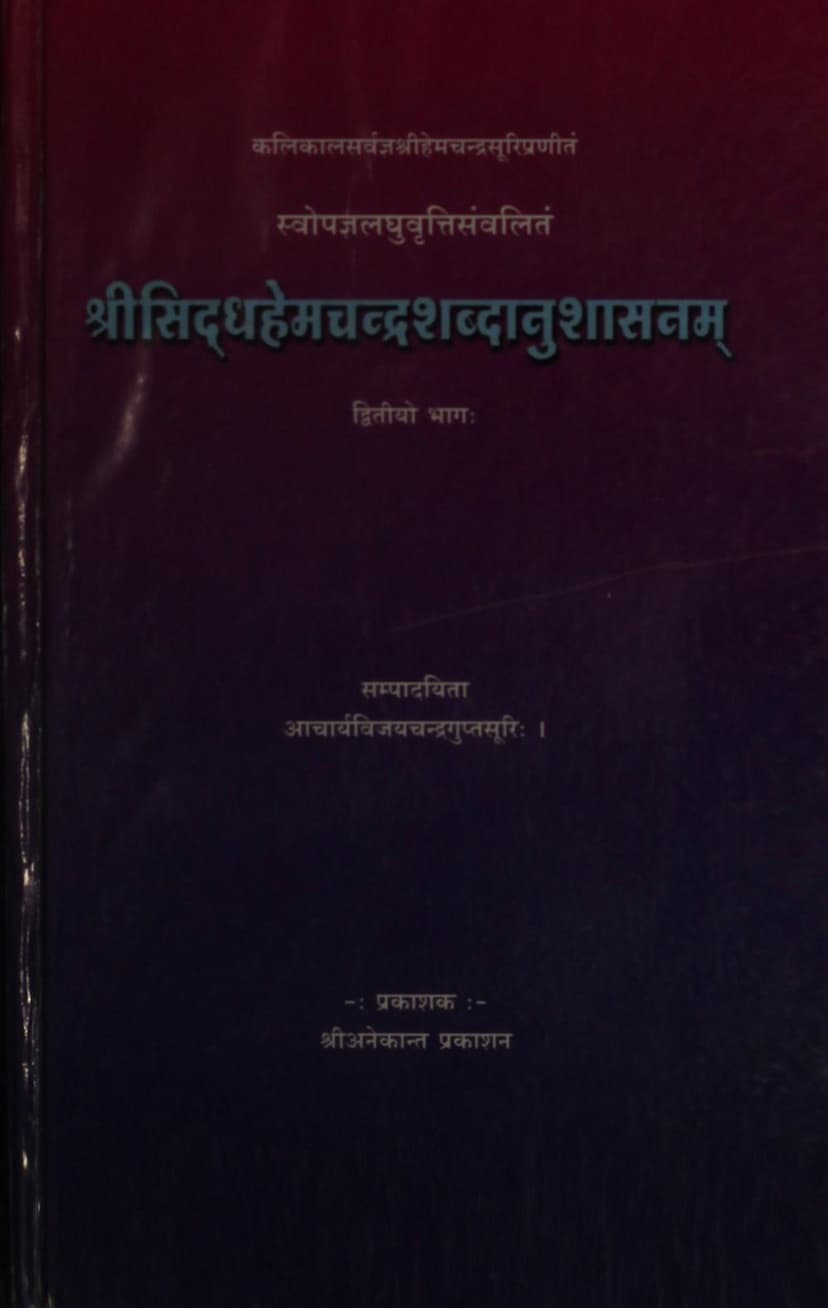Siddha Hemchandrashabdanu Shasanam Part 2
Added to library: September 2, 2025

Summary
Here's a comprehensive summary of the provided Jain text, "Siddha Hemchandrashabdanu Shasanam Part 2," based on the pages you've shared:
Overall Work:
- Title: Shri Siddha Hemchandrashabdanu Shasanam (श्रीसिद्धहेमचन्द्रशब्दानुशासनम्)
- Author: Kalikal Sarvajña Shri Hemchandracharya (कलिकालसर्वज्ञश्रीहेमचन्द्रसूरि)
- Commentary: Swopajnya Laghu Vrutti Samvalitam (स्वोपज्ञलघुवृत्तिसंवलितं) - meaning, composed with his own concise commentary.
- Editor/Compiler: Acharya Vijay Chandraguptasuri (आचार्यविजयचन्द्रगुप्तसूरि)
- Publisher: Shri Anekant Prakashan (श्रीअनेकान्त प्रकाशन)
- Volume: Part 2 (द्वितीयो भाग:)
- Edition: Second (आवृत्तिः - द्वितीया)
- Print Run: 750 copies
- Price: 80 Rupees
- Publication Date: Kartik Shukla 10, V.S. 2056 (November 1999)
- Financial Support: Shri Salvi Nadi Aadesh Bhagwan Jain Derasar Trust, Chapariya Sheri, Mahidharpura, Surat.
Content Summary (Based on Page 6 onwards):
The provided pages of Part 2 focus on grammatical rules, specifically within the context of Sanskrit (or Prakrit, given the commentary'8th chapter structure, but the examples and terminology are strongly Sanskrit-based). The text is a detailed grammatical treatise, likely following the structure of Panini's Ashtadhyayi or a similar influential Sanskrit grammar.
The excerpt begins with Chapter 5, First Chapter (Pāda), which appears to deal with "Kṛt" (कृत्) suffixes and related formations. The rules cover:
- Definition of Kṛt: Suffixes that derive nouns from verbal roots.
- Usage of Kṛt suffixes: Rules regarding whether they are used in the active voice (Kartari - कर्तरि), passive voice, or other grammatical cases (like the dative - Sampradāna - संप्रदान).
- Specific suffixes and their applications: The text details the application of various suffixes like '-ya' (य), '-tul' (तुमुन्), '-kyap' (क्यप्), '-dhya' (ध्य), '-tavya' (तव्य), '-aniya' (अनीय), '-kta' (क्त), '-k' (क), '-ś' (श), '-n' (ण), '-kaṭ' (कट्), '-yaka' (यक), '-na' (ण), '-kvin' (क्विन्), '-kvip' (क्विप्), '-kvanip' (क्वनिप्), '-ktvā' (क्त्वा), '-tum' (तुमुन्), '-bhyam' (भ्यम्), etc.
- Conditions for suffix usage: The rules are often conditional, depending on the meaning of the verb (e.g., for beginning - Ārambhe - आरम्भे), the tense (e.g., past tense - Bhutādou - भूतादौ), the grammatical case of the noun or object, or specific contexts like "in a rite" (Kratou - क्रतौ), "in a dwelling" (Nivāse - निवासे), or "for the purpose of making" (Karaṇe - करणे).
- Vowel and consonant changes: Rules also govern how the root verb's letters and vowels change when these suffixes are applied.
- Nipātas (Idiomatic formations): Several rules mention that certain forms are "nipātyate" (निपात्यते), meaning they are established idiomatically and don't strictly follow the regular rules, often signifying a special usage.
- Examples: Each rule is followed by illustrative examples showing the application of the rule. For instance, for the suffix '-tul', examples like 'Gha-ghātyaḥ' (घनघात्यः), 'atyādira' (अत्यादिः), and 'praṇiste' (प्रणिस्ते) are given. For '-kta', examples like 'āśliṣṭaḥ kāntāṁ caitraḥ' (आश्लिष्टः कान्तां चैत्रः) are provided, demonstrating different grammatical relationships.
Chapter Structure (as indicated):
The excerpt shows the beginning of Chapter 5 (Pañcamō'dhyāyaḥ - पञ्चमोऽध्यायः), and specifically Pāda 1 (प्रथमः पादः - 5.1). It then proceeds through various rules (sūtras) indicated by numbers like 5.1.1, 5.1.2, and so on, up to 5.1.171, indicating a very extensive treatment of the topic of Kṛt formations and related word derivations.
Key Themes and Grammatical Concepts:
- Nominalization: The primary focus is on how verbal roots (Dhātu - धातु) are transformed into nouns or adjectives through the application of various suffixes.
- Voice and Case: A significant aspect is determining the grammatical voice (active/passive) and case in which these derived words are used.
- Root Modification: The rules detail how root verbs are modified (e.g., vowel changes, consonant changes, additions) before suffixes are applied.
- Semantic Context: The choice of suffix and its meaning is often determined by the context or the intended meaning (e.g., suitability for carrying, ability, belonging, purpose, etc.).
- Systematic Approach: The text follows a highly systematic, rule-based approach characteristic of classical Sanskrit grammar, with precise definitions and numerous examples.
In essence, this part of the Siddha Hemchandrashabdanu Shasanam is a foundational section of the grammar, explaining the process of deriving various words from verb roots using specific suffixes, detailing the conditions, exceptions, and resulting forms with clarity and numerous examples.